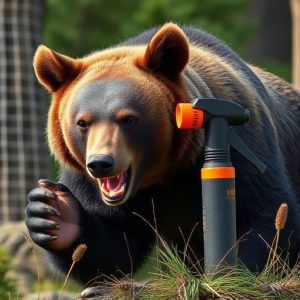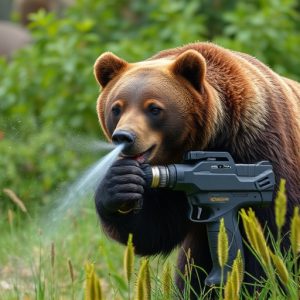Optimize Bear Defense: Quick Draw Access & Canister Replacement Guide
In bear country, a properly fitted and easily accessible bear spray holster is crucial defense. Regu…….
In bear country, a properly fitted and easily accessible bear spray holster is crucial defense. Regularly inspect and replace canisters every 3-5 years or sooner if damaged, leaking, or corroded to maintain effectiveness. Follow manufacturer guidelines for optimal protection, focusing on deployment distance, canister condition, and storage conditions. Practice quick draws, keep holsters in safe, dry places, and be aware of surroundings to enhance safety during potential wildlife encounters. Timely replacement is key for optimal protection.
Bear spray is a vital tool for outdoor enthusiasts navigating wild territories. Understanding the quick-draw access of your bear spray holster and knowing when to replace your canister are essential skills for safety in bear country. This guide delves into these critical aspects, exploring factors influencing bear spray range and deployment effectiveness. We’ll also share best practices for maintenance and usage, ensuring you’re prepared for unexpected encounters with these majestic yet potentially dangerous creatures. Remember, timely canister replacement can mean the difference between a close call and a safer outdoor experience.
- Understanding Bear Spray Holster Quick Draw Access
- When to Replace Your Bear Spray Canister
- Factors Affecting Bear Spray Effective Range and Deployment
- Best Practices for Maintaining and Using Your Bear Spray Gear
Understanding Bear Spray Holster Quick Draw Access
In the event of a bear encounter, quick access to your bear spray can be a matter of life and death. A holster designed for swift and easy retrieval of your spray is therefore an essential component of any outdoor gear for bear country. Understanding how to efficiently draw your bear spray from its holster in a split second can make all the difference during an unexpected attack. The term ‘quick draw’ refers to the ease and speed at which you can grasp, deploy, and aim your spray, ensuring maximum protection against potential bear threats.
Knowing when to replace your bear spray canister is crucial for maintaining its effectiveness. Canisters should be replaced regularly, as they have a limited lifespan and can degrade over time, especially in harsh environmental conditions. The ‘When to Replace Bear Spray Canister’ question is a vital consideration for outdoor enthusiasts to ensure their safety and the reliability of their defense against bears. Regular inspections can help determine if your canister is still in optimal condition, allowing you to stay prepared during any potential encounters.
When to Replace Your Bear Spray Canister
Knowing when to replace your bear spray canister is crucial for your safety in potential wildlife encounters. While bear spray is a valuable tool for deterring aggressive bears, its effectiveness depends on proper maintenance and timely replacement. Canisters should be replaced after 3-5 years, or if they show signs of damage or leakage. Even if the canister looks intact, it’s best to replace it after this period as the chemical composition may degrade over time, reducing its potency.
Regular inspection is key. Check for any rust, corrosion, or physical dents that could compromise the integrity of the container. If you live in areas with frequent bear activity or extreme weather conditions, consider replacing your canister more frequently to ensure optimal protection. Always follow manufacturer guidelines and stay updated on recommended replacement intervals to make informed decisions regarding your safety gear.
Factors Affecting Bear Spray Effective Range and Deployment
The effectiveness of bear spray in a confrontation depends on several key factors. One primary consideration is the distance at which deployment occurs. Bear spray holsters designed for quick draw access ensure users can dispense the spray at optimal range, typically between 20 to 30 feet (6 to 9 meters). This range allows individuals to create a protective barrier without risking close contact with the bear.
Another crucial aspect is the condition and age of the bear spray canister. It’s recommended to replace bear spray canisters when they start to show signs of wear or after a certain number of years, as specified by the manufacturer. When to replace bear spray canister varies based on usage frequency and storage conditions, but generally, it’s wise to inspect canisters regularly for any damage or corrosion that could compromise their integrity during use.
Best Practices for Maintaining and Using Your Bear Spray Gear
When using any bear spray gear, proper maintenance is key. Regularly inspect your canister for any signs of damage or corrosion, as this can compromise its effectiveness. Check the expiration date on the canister to ensure it hasn’t passed; bear spray typically has a shelf life of several years but can degrade over time, especially in extreme temperatures. Always keep your spray holster in a safe, dry place and make sure the trigger is protected from accidental activation.
During use, rapid draw access is crucial for your safety. Practice drawing your spray quickly and smoothly to ensure you can deploy it as needed. Keep your target in sight until the canister is empty, as bear spray has a limited range and accuracy. Remember, the best defense is always prevention, so stay aware of your surroundings and make noise when hiking or camping in bear country. Knowing how to use your gear and maintaining it properly could be a matter of life and death. In terms of when to replace your canister, look out for any signs of damage or if the spray pattern becomes inconsistent, indicating that its power has diminished.
Bear spray is a valuable tool for outdoor enthusiasts navigating bear country, but proper maintenance and awareness of its limitations are key. Regularly checking and replacing your canister according to manufacturer recommendations is essential, as is understanding the factors impacting effective range and deployment. By following best practices for use and storage, you can ensure your gear is reliable when you need it most, enhancing safety during encounters with these majestic yet potentially dangerous animals.


